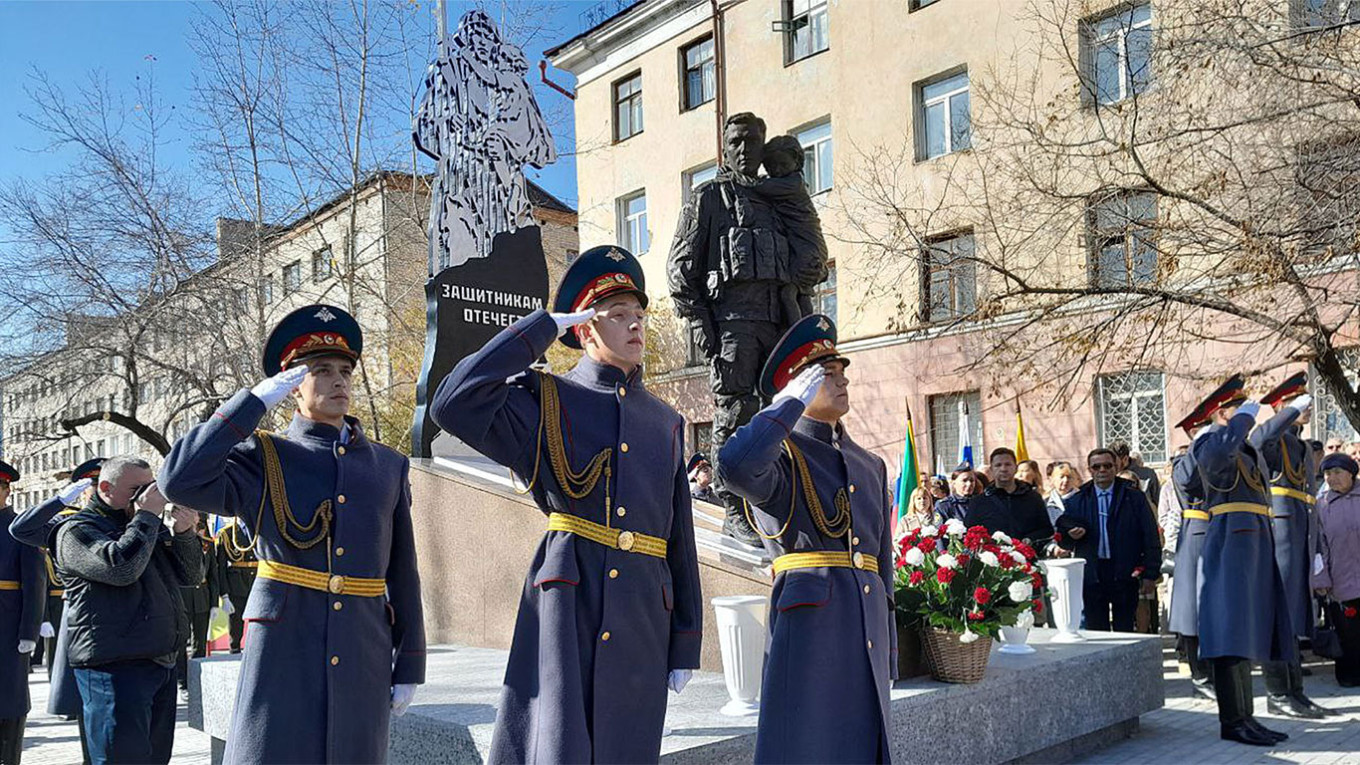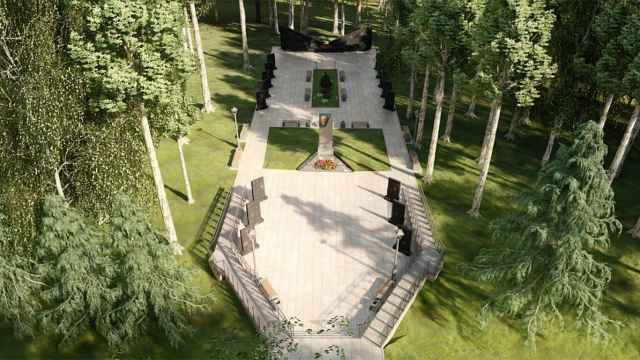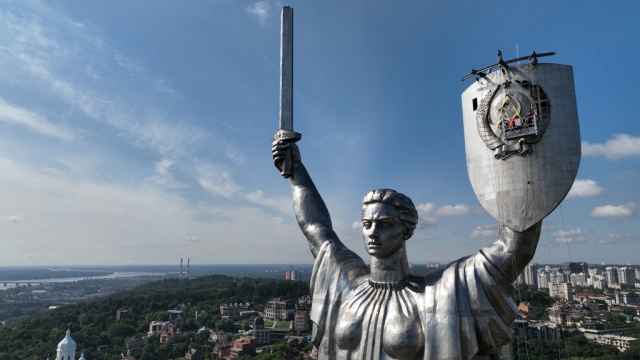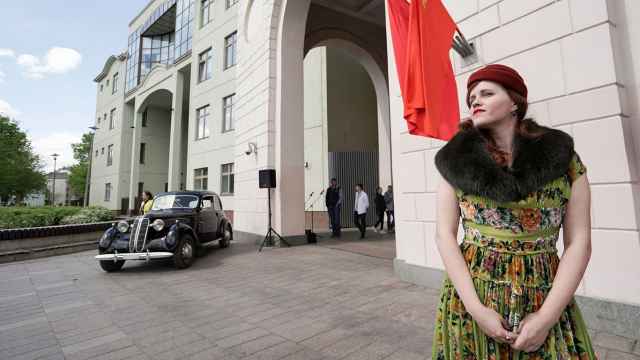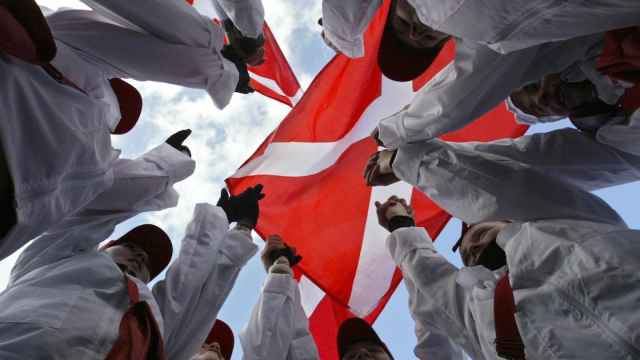Authorities in Russia’s Zabaikalsky region in October unveiled the region’s largest memorial dedicated to Russian soldiers killed in the war in Ukraine: a 3.3-meter-tall stele and a statue of a soldier holding a child erected in the very heart of the region's capital Chita.
The Zabaikalsky region, a swathe of Russia’s Far East with a population of just over 1 million, has one of the highest war death tolls among all regions with at least 774 residents killed fighting in Ukraine since February 2022, according to independent tallies.
Yet the plan to set in stone a reminder of the war raging thousands of kilometers to the west was initially opposed by residents, who deemed the 5.6-million-ruble ($63,000) memorial to be a more appropriate addition to a local cemetery than a historic city center.
“There are places of mourning and there are places of normal life. I mean, we don’t bury the dead under our windows, do we?” activist Marina Savvateeva told the local news outlet Chita.ru.
The monument in Chita is just one of thousands of statues, memorial plaques, and tall engraved stone slabs — known as steles — commemorating Russian soldiers killed in Ukraine that have appeared across the country since the start of the Ukraine war.
But while Russia’s invasion of its neighbor is being immortalized in stone, memorials dedicated to Soviet-era repressions, some of the darkest pages of the country’s history, are disappearing en masse in what experts say signals a worrying trend.
“I monitor all memorial plaque openings in Russia. I see plaques dedicated to writers or other cultural figures being installed too, but their number just can’t compare to those dedicated to soldiers,” said Alexandra Polivanova of the Nobel Peace Prize-winning Memorial human rights group.
Data collected by Polivanova indicates that at least 3,187 memorials commemorating Russian soldiers killed in Ukraine have been opened across the country in 649 days of the Kremlin’s invasion — an average of five plaques per day.
While some of these memorials are large installations or statues meant to honor all “heroes of the special military operation in Ukraine,” most are simple plaques, posters, murals or even decorated desks dedicated to individual soldiers and placed in schools or colleges that the fallen “heroes” once attended.
“It is really important for the Russian state to get people in Russia to believe in their war in Ukraine and they try to do that by [introducing] faces of war into everyday life,” said Allyson Edwards, a specialist in Russian memory politics at Bath Spa University.
“Monuments elevate these soldiers from an ordinary Russian person drafted to fight in the war into someone who has done something exceptional enough to have a monument…dedicated to them,” Edwards told The Moscow Times.
Installations glorifying the Kremlin’s invasion of neighboring Ukraine are just one type of propaganda consumed daily by ordinary Russians.
At the same time, at least 23 monuments to victims of Stalin’s Red Terror have been vandalized or dismantled across the country since the start of the war in Ukraine, according to Memorial’s counts.
“We are certain that all of these actions are sponsored by the government one way or another,” Memorial’s Polivanova told The Moscow Times.
Memorials dedicated to individual ethno-confessional groups that suffered from Soviet imperial expansion are most frequently targeted, according to Polivanova.
In July, a granite cross commemorating persecuted Poles vanished from St. Petersburg’s Levashovo Memorial Cemetery, where more than 45,000 victims of Stalin’s terror are believed to have been buried.
A few months earlier, a memorial to Ukrainian victims of Stalinist purges at the same cemetery was vandalized. A similar fate was met by other memorials to persecuted Poles and Lithuanians elsewhere in the country, including the Far East republic of Sakha (Yakutia), Siberia’s Tomsk region and the Sverdlovsk region in the Ural mountains.
And dozens of plaques honoring victims of the Soviet gulag forced labor camps have disappeared from buildings throughout the capital Moscow since the start of the year.
“It is not surprising that such monuments are not welcome during a time when Russia is again conducting an imperial war of conquest,” said Polivanova.
Polivanova said she believes that behind the destruction of memorials to victims of Soviet repressions lays not only the state’s desire to downplay the darkest pages of Russia’s past, but also to tighten its grip on unwelcome actions of the present, as many of these sites have taken on a second meaning since the invasion of Ukraine.
With limited legal avenues for expressing solidarity with Ukrainians being available to them, individual Russians often respond to their country’s gruesome attacks on Ukrainian civilians by placing flowers, candles, and other tokens of their sorrow at memorials to well-known Ukrainian cultural figures as a way to honor the dead.
But in cities with no monuments to Ukrainian luminaries such as writer Taras Shevchenko or poet Lesya Ukrainka, people have brought flowers, candles and handwritten notes to monuments of victims of Soviet repressions.
“People understand that they are again dealing with … a government that is completely indifferent to [the value of] human life, the lives of its citizens and those of other states,” said Polivanova. “The only thing this government cares about is territories.”
Grassroots activists have been instrumental in spreading awareness of the destruction of memorials and restoring the sights of mourning.
Memorial activists in St. Petersburg erected a new memorial to Polish victims of terror in place of the destroyed cross at Levashovo Memorial Cemetery, though the new statue, too, soon mysteriously disappeared.
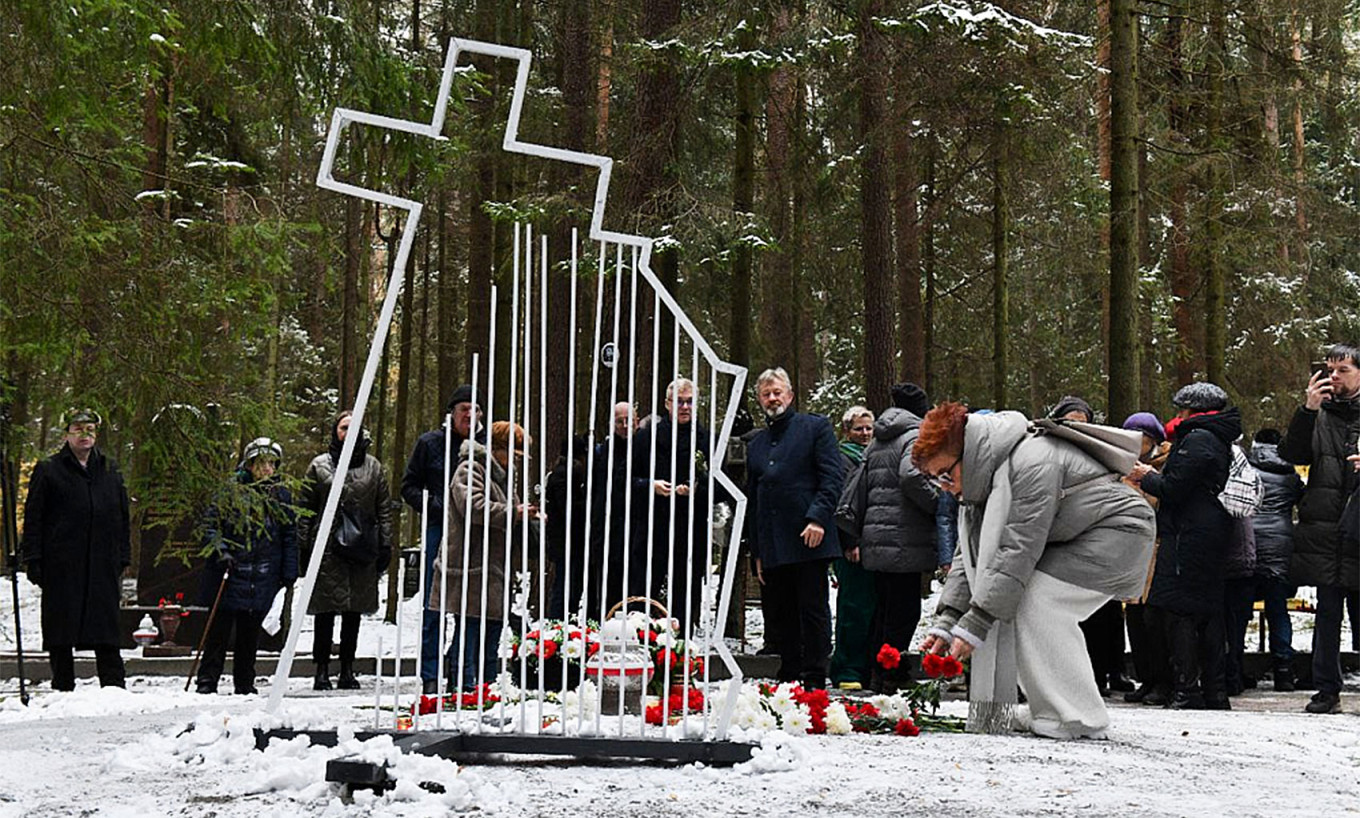
And in Moscow, activists have been putting up hand-written cardboard plaques in place of the vanished metal signs honoring gulag victims.
“It is important to understand that memorial plaques to Russian soldiers…are created by the state. The state makes them because it understands that the level of faith in the war is very low and it seeks legitimacy by setting it in stone,” Polivanova explained.
“Spontaneous grassroots initiatives are the ones that are trusted by the people. They are the real and honest ones.”
A Message from The Moscow Times:
Dear readers,
We are facing unprecedented challenges. Russia's Prosecutor General's Office has designated The Moscow Times as an "undesirable" organization, criminalizing our work and putting our staff at risk of prosecution. This follows our earlier unjust labeling as a "foreign agent."
These actions are direct attempts to silence independent journalism in Russia. The authorities claim our work "discredits the decisions of the Russian leadership." We see things differently: we strive to provide accurate, unbiased reporting on Russia.
We, the journalists of The Moscow Times, refuse to be silenced. But to continue our work, we need your help.
Your support, no matter how small, makes a world of difference. If you can, please support us monthly starting from just $2. It's quick to set up, and every contribution makes a significant impact.
By supporting The Moscow Times, you're defending open, independent journalism in the face of repression. Thank you for standing with us.
Remind me later.



